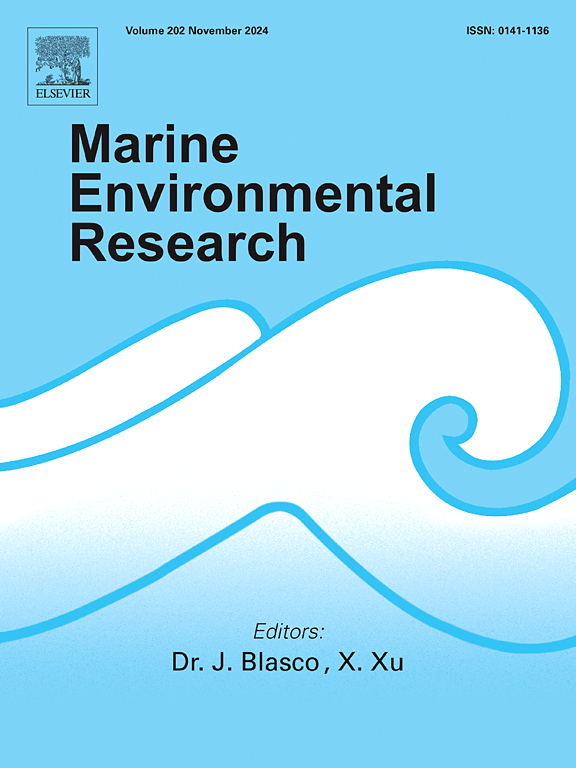Fluctuations in sediment blue carbon density associated with land use changes and mangrove distribution along the semiarid, rapidly industrializing coastline of India
IF 3
3区 环境科学与生态学
Q2 ENVIRONMENTAL SCIENCES
引用次数: 0
Abstract
Mangrove ecosystems can sequester blue carbon, yet anthropogenic activities increasingly threaten it's habitat and carbon storage capacity. The blue carbon sequestration potential of mangroves is an underexplored avenue in climate change science. The sustainable development goal (SDG)13 strongly emphasizes the need to reduce carbon emissions, whereas SDG 14 focuses on conserving coastal and marine ecosystems Understanding mangroves' essential ecosystem services, primarily ‘blue carbon’, distributed in different climatic zones is being prioritized by academics and policymakers. The Indian subcontinent is endowed with mangroves along its different coasts; however, the semiarid mangrove patches only exist in the western Indian district of Kachchh and are largely, unexplored. In our present study, we conducted a comprehensive assessment of sediment carbon stocks across multiple sites subjected to varying degrees of industrialization, urbanization, and agricultural encroachment along the coastline of Kachchh mangroves. Sediment cores were obtained from mangrove areas categorized as pristine, moderately impacted, and heavily industrialized to measure organic carbon content and assess its relationship with Normalized Difference Vegetation Index (NDVI). The approach aimed to evaluate variations in the blue carbon pool concerning different land use patterns. Seasonal sampling of mangrove sediments was conducted in both anthropogenically impacted and unaffected zones, with the resulting data analyzed using a three-way ANOVA (analysis of variance) within GLM (general linear model). A relationship was observed between anthropogenic activities and values of organic carbon density (OCD) and blue carbon pool. Respite of Mangrove restoration activities, the human intervention led to lower OCD values (1.2 % and 1.4 %, S.E. = ±.56) near industrial activity zones. This calls for combined efforts from all sectors to restore these fragile ecosystems in the region. The contributing role of mangroves as blue carbon sink is important in the fight against climate change.
印度半干旱、快速工业化的海岸线上与土地利用变化和红树林分布相关的沉积物蓝碳密度波动
红树林生态系统可以吸收蓝碳,但人类活动日益威胁到它的栖息地和碳储存能力。在气候变化科学中,红树林的蓝色碳封存潜力尚未得到充分开发。可持续发展目标13强烈强调减少碳排放的必要性,而可持续发展目标14则侧重于保护沿海和海洋生态系统。了解分布在不同气候带的红树林的基本生态系统服务功能,主要是“蓝碳”,正成为学术界和政策制定者的优先事项。印度次大陆在其不同的海岸被赋予了红树林;然而,半干旱的红树林只存在于印度西部的Kachchh地区,而且大部分都没有被开发过。在本研究中,我们对Kachchh红树林海岸线沿线多个地点遭受不同程度的工业化、城市化和农业侵蚀的沉积物碳储量进行了综合评估。在原始、中等影响和工业化程度较高的红树林地区获取沉积物岩心,测量有机碳含量,并评估其与归一化植被指数(NDVI)的关系。该方法旨在评估不同土地利用模式下蓝碳库的变化。在受人为影响和未受影响的地区对红树林沉积物进行了季节性采样,并使用GLM(一般线性模型)中的三向方差分析(方差分析)对所得数据进行了分析。人类活动与有机碳密度(OCD)值和蓝碳库值之间存在一定的关系。在红树林恢复活动暂停期间,人为干预导致工业活动区附近OCD值较低(分别为1.2%和1.4%,S.E. =±0.56)。这需要所有部门共同努力,恢复该地区脆弱的生态系统。红树林作为蓝色碳汇的贡献作用在应对气候变化的斗争中非常重要。
本文章由计算机程序翻译,如有差异,请以英文原文为准。
求助全文
约1分钟内获得全文
求助全文
来源期刊

Marine environmental research
环境科学-毒理学
CiteScore
5.90
自引率
3.00%
发文量
217
审稿时长
46 days
期刊介绍:
Marine Environmental Research publishes original research papers on chemical, physical, and biological interactions in the oceans and coastal waters. The journal serves as a forum for new information on biology, chemistry, and toxicology and syntheses that advance understanding of marine environmental processes.
Submission of multidisciplinary studies is encouraged. Studies that utilize experimental approaches to clarify the roles of anthropogenic and natural causes of changes in marine ecosystems are especially welcome, as are those studies that represent new developments of a theoretical or conceptual aspect of marine science. All papers published in this journal are reviewed by qualified peers prior to acceptance and publication. Examples of topics considered to be appropriate for the journal include, but are not limited to, the following:
– The extent, persistence, and consequences of change and the recovery from such change in natural marine systems
– The biochemical, physiological, and ecological consequences of contaminants to marine organisms and ecosystems
– The biogeochemistry of naturally occurring and anthropogenic substances
– Models that describe and predict the above processes
– Monitoring studies, to the extent that their results provide new information on functional processes
– Methodological papers describing improved quantitative techniques for the marine sciences.
 求助内容:
求助内容: 应助结果提醒方式:
应助结果提醒方式:


